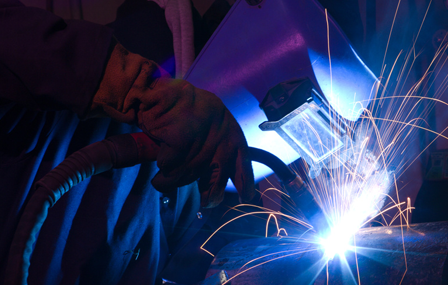To that end, filler metal manufacturers rigorously test products to guarantee they meet minimum specifications, based on American Welding Society (AWS) and other industry standards. Filler metals’ general mechanical values are some degrees higher than the AWS minimums.
However, there are welding variables that can impact the finished weld properties, even when using the same filler metal. As a result, mechanical properties, such as tensile strength, ductility and yield strength can vary greatly from weld to weld.
Consider this example: An AWS E71T-1 gas-shielded carbon steel flux-cored wire usually provides 74,000-lb/in.² tensile strength. Adjusting the amount of shielding gas and welding parameters can make the weld possess over 90,000-lb/in.² tensile strength — with that same filler metal.
Understanding the ways in which variations in heat input and shielding gases, especially, affect weld deposit properties is crucial. It helps ensure the weld stands up to the necessary strength and quality requirements.
Mechanical Properties Defined
- Tensile strength is the maximum force required to produce failure.
- Ductility refers to how much the material can stretch before it fractures.
- Yield strength is the force required to cause a material to plastically deform or yield.
- Heat input (kJ/in.) = [amps x volts x 60] / [1000 x (travel speed in in./min)]
- Elongation is a measurement of a material’s ductility expressed in a percentage.
Features of the Heat Input and Mechanical Properties
Adjustments in heat input can cause significant variances in the ductility of a weld, as well as its tensile and yield strengths. A material’s strength and its ductility are related. Ductility decreases as strength increases, and vice versa. The general rule is that higher strength equals increased brittleness; however, higher strengths may be required in certain applications.
With lower heat inputs, the strength of the weld deposit increases. Using a lower heat input will typically result in smaller welds and requires more weld passes to fill the joint. In addition to the changes in strength, lowering heat input will also reduce ductility, which can make the finished weld more susceptible to cracking.
Conversely, completing a weld with higher heat input results in larger weld deposits and requires fewer passes to fill a joint. While this improves ductility and resistance to cracking, it lowers tensile and yield strength, which is a disadvantage if the reduction is enough to cause the weld to fall below minimum requirements.
For example, an AWS E71T-1C or E71T-1M carbon steel wire, when used with a low heat input of 30 kJ/in., produces a tensile strength of 93,800 lb/in.², a yield strength of 89,300 lb/in.², and an elongation of 24 percent. Compare that to the same wired used with a high heat input of 80 kJ/in., which produces a tensile strength of 81,500 lb/in.², a yield strength of 70,200 lb/in.², and elongation of 29 percent.
There are pros and cons with each of the heat input options, the ideal choice depends on the application’s requirements. For the best results, consult the filler metal manufacturer’s recommended parameters for a specific product to help avoid issues caused by excessively high or low heat inputs. These recommendations suggest heat input ranges to produce the desired strength and ductility results.
Shielding Gas Impact
Additionally, shielding gas selection affects the mechanical properties of a weld. There are a few general factors to consider when using argon mixtures versus straight CO2 shielding gas. The scenarios are very similar to those regarding heat input variations, with the same relationship between strength and ductility.
Shielding gas with higher argon content results in welds with higher tensile and yield strengths and lower ductility. Again, the higher strength may or may not be needed for the application, and the disadvantage is that the weld is more susceptible to cracking.
On the other hand, higher CO2 content in a shielding gas mixture improves ductility and crack resistance but lowers the tensile and yield strengths. As a result, the weld may fail minimum requirement standards if the numbers drop below necessary levels.
Consider the different variances produced in this example: The same E71T-1C or E71T-1M wire mentioned previously used with 100 percent CO2 gas provides a tensile strength of 84,000 lb/in.2, a yield strength of 77,000 lb/in.2, and 28 percent elongation. The same wire used with a gas mixture of 75 percent argon/25 percent CO2 results in a tensile strength of 90,000 lb/in.2, a yield strength of 83,000 lb/in.2 and elongation of 26 percent.
There is more to consider when selecting shielding gas. Shielding gas selection factors in weldability, fume requirements, arc qualities and more. However, the change in mechanical properties that shielding gas can cause should always be considered, as it directly affects the weld quality.
The Combination of Heat Input and Shielding Gas
High heat input and CO2 can have a similar effect on mechanical properties (reducing strength and increasing ductility), and lower heat inputs and high argon content gas will do the opposite (push strength up and ductility down), so these variables can be used together to compound these effects or to offset each other.
For instance, in an applicator where a high heat input is causing strength to drop, selecting a gas with a higher argon content can help increase strength levels. On the other hand, lower heat input may cause a lack of ductility and CO2 shielding gas can be used to minimize that effect.
Using the same carbon steel gas-shielded wire as in the previous examples, a high heat input with 100 percent CO2 combination results in a tensile strength of 81,500 lb/in.2, a yield strength of 70,200 lb/in.2, and 29 percent elongation. That compares to a low heat input with 75 percent argon gas, which results in 104,400 lb/in.2 tensile strength, 98,600 lb/in.2 yield strength, and 22 percent elongation (which is the minimum requirement).
Whether or not combining these factors to work together is the appropriate solution depends upon the filler metal, as some are more or less affected than others. Also, certain filler metals are formulated for dual gas usage, while others can only be used with a single gas.
Understand the Dynamics
There are no absolutes regarding the choice of high heat or low heat, or using an argon or CO2 shielding gas — which option is the better choice all depends on the needs and requirements of the specific application and wire. That makes it particularly important to understand the relationship between these variables and the impact each has on the mechanical properties of the weld. Knowing how to adjust heat and the impact of shielding gas to help produce the desired effect can help welding operators refine their process and ultimately improve their results.



Bo Brewer liked this on Facebook.